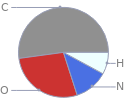Input interpretation

DL-proline | elemental composition
Result

Find the elemental composition for DL-proline in terms of the atom and mass percents: atom percent = N_i/N_atoms × 100% mass percent = (N_im_i)/m × 100% Plan: • Write the chemical formula and gather atomic masses from the periodic table. • Determine values for N_i, m_i, N_atoms and m using these items. • Finally, compute the percents and check the results. Write the chemical formula: C_5H_9NO_2 Use the chemical formula, C_5H_9NO_2, to count the number of atoms, N_i, for each element and find the total number of atoms, N_atoms: | number of atoms C (carbon) | 5 H (hydrogen) | 9 N (nitrogen) | 1 O (oxygen) | 2 N_atoms = 5 + 9 + 1 + 2 = 17 Divide each N_i by N_atoms to calculate atom fractions. Then use the property that atom fractions must sum to one to check the work: | number of atoms | atom fraction C (carbon) | 5 | 5/17 H (hydrogen) | 9 | 9/17 N (nitrogen) | 1 | 1/17 O (oxygen) | 2 | 2/17 Check: 5/17 + 9/17 + 1/17 + 2/17 = 1 Compute atom percents using the atom fractions: | number of atoms | atom percent C (carbon) | 5 | 5/17 × 100% = 29.4% H (hydrogen) | 9 | 9/17 × 100% = 52.9% N (nitrogen) | 1 | 1/17 × 100% = 5.88% O (oxygen) | 2 | 2/17 × 100% = 11.8% Look up the atomic mass, m_i, in unified atomic mass units, u, for each element in the periodic table: | number of atoms | atom percent | atomic mass/u C (carbon) | 5 | 29.4% | 12.011 H (hydrogen) | 9 | 52.9% | 1.008 N (nitrogen) | 1 | 5.88% | 14.007 O (oxygen) | 2 | 11.8% | 15.999 Multiply N_i by m_i to compute the mass for each element. Then sum those values to compute the molecular mass, m: | number of atoms | atom percent | atomic mass/u | mass/u C (carbon) | 5 | 29.4% | 12.011 | 5 × 12.011 = 60.055 H (hydrogen) | 9 | 52.9% | 1.008 | 9 × 1.008 = 9.072 N (nitrogen) | 1 | 5.88% | 14.007 | 1 × 14.007 = 14.007 O (oxygen) | 2 | 11.8% | 15.999 | 2 × 15.999 = 31.998 m = 60.055 u + 9.072 u + 14.007 u + 31.998 u = 115.132 u Divide the mass for each element by m to calculate mass fractions. Then use the property that mass fractions must sum to one to check the work: | number of atoms | atom percent | mass fraction C (carbon) | 5 | 29.4% | 60.055/115.132 H (hydrogen) | 9 | 52.9% | 9.072/115.132 N (nitrogen) | 1 | 5.88% | 14.007/115.132 O (oxygen) | 2 | 11.8% | 31.998/115.132 Check: 60.055/115.132 + 9.072/115.132 + 14.007/115.132 + 31.998/115.132 = 1 Compute mass percents using the mass fractions: Answer: | | | number of atoms | atom percent | mass percent C (carbon) | 5 | 29.4% | 60.055/115.132 × 100% = 52.16% H (hydrogen) | 9 | 52.9% | 9.072/115.132 × 100% = 7.880% N (nitrogen) | 1 | 5.88% | 14.007/115.132 × 100% = 12.17% O (oxygen) | 2 | 11.8% | 31.998/115.132 × 100% = 27.79%
Mass fraction pie chart

Mass fraction pie chart